Author: 0xJeff, founder of Steak Studio; Translator: Jinse Finance xiaozou
DeFi has always been the pillar of Web3. It is DeFi that has demonstrated the practical use of blockchain, providing us with the necessary tools to achieve instant global remittances, on-chain asset investments, peer-to-peer lending without intermediaries, and cross-DeFi protocol strategies, all within reach of financial freedom.
More importantly, DeFi solves real-world problems. It enables those without traditional bank accounts to access financial services, eliminates intermediaries, and can operate 24/7, creating a truly inclusive global financial system.
But let's face an obvious fact: DeFi is very complex.
Setting up a wallet, managing gas fees, and learning to avoid scams in a fraud-ridden environment - it's not very user-friendly. The proliferation of L1, L2, and cross-chain ecosystems only makes things more complicated. The entry barrier is too high for most people.
This complexity has hindered the growth of DeFi, but DeFAI is starting to change that.
What is DeFAI?
DeFAI (DeFi + AI) makes DeFi more accessible. DeFAI utilizes artificial intelligence to simplify complex interfaces and eliminate the barriers that prevent ordinary people from participating. Imagine a world where managing your DeFi portfolio is as easy as chatting with ChatGPT.
The first wave of DeFAI projects has already emerged, focusing mainly on three areas:
Abstraction Layers
Autonomous Trading Agents
AI-driven dApps
1. Abstraction Layers
The purpose of abstraction layers is to make DeFi more accessible by hiding the complexity of DeFi behind intuitive interfaces. Abstraction layers enable users to interact with DeFi protocols using natural language commands instead of complex dashboards.
Before the advent of AI, abstraction layers like intent-based architectures simplified the execution of transactions. Platforms like CoWSwap and SYMMIO allow users to obtain the best pricing in decentralized liquidity pools, solving the problem of liquidity fragmentation, but they did not address the core issue: DeFi is still daunting.
Now, AI-based solutions are filling this gap:
Griffain is the first solution to launch a token, still in early access mode with invitations required. Griffain is more versatile, allowing users to perform various basic or complex operations, such as task automation (DCA), meme coin creation, and airdropping meme coins according to standards.
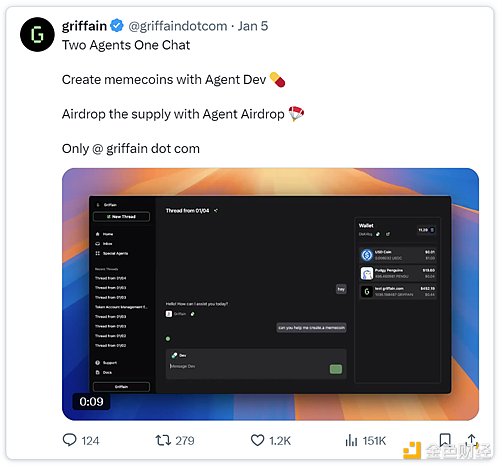
Orbit / Grift is the second solution to launch a token, focused on on-chain DeFi experiences. Orbit emphasizes cross-chain functionality, integrating over 200 protocols across more than 117 chains, making it the most integrated of the three solutions.
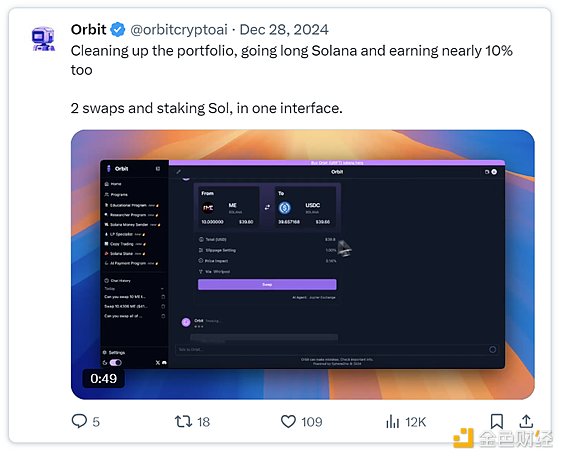
Neur is the third solution to be launched, but due to its open-source nature, its valuation quickly surpassed Orbit. Neur positions itself as a Solana co-pilot designed specifically for the Solana ecosystem, supported by the SendAI Solana Agent Kit.
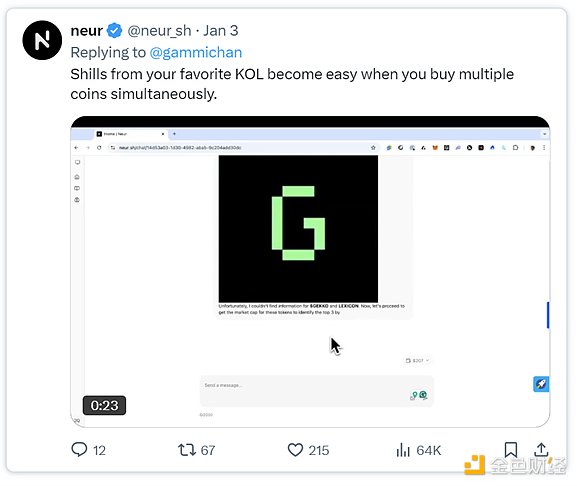
I personally use Slate, which is still in the early stages and has not yet launched a token, but I like its automation features. I mainly use it to set up conditional trades, such as selling 25% of a position if [xxx]'s market cap reaches $5 million, or buying $5,000 worth of tokens if [xxx] reaches [xxxx] price.
Wayfinder Foundation is another interesting application worth noting. It is a massive project being built by the PRIME / Parallel team.
2. Autonomous Trading Agents
Why spend hours digging for alpha, manually executing trades, and trying to optimize your portfolio when you can delegate these tasks to an agent? Autonomous trading agents are taking the concept of trading bots to a new level, transforming them into dynamic partners that can adapt, learn, and make wiser decisions over time.
It's important to note that trading bots are not a new concept. They have existed for years, executing predefined actions based on static programming. But agents are fundamentally different:
They extract information from unstructured, constantly changing environments.
They reason about data in the context of their objectives.
They discover patterns and learn to leverage them over time.
They can perform actions their owners have never explicitly programmed.
This sub-sector is rapidly evolving. Initially, it was for entertainment purposes, but now it has shifted towards practical, profit-driven tools that can help users trade more effectively. However, there is a critical challenge: How do you verify that an "agent" is not just a bot, or even a human operating behind the scenes?
This is where DeAI infrastructure comes into play.
The role of DeAI in verifying agents
Key infrastructures like Trusted Execution Environments (TEE) ensure that agents run securely and without tampering.
For example:
TEE: TEE, promoted by Phala Network, provides secure enclaves where data is processed confidentially. Phala's experiments, such as Unruggable ICO and Sporedotfun, have demonstrated how agents can execute tasks while maintaining data integrity.
Transparent Execution/Verification Frameworks: Innovations like zkML (zero-knowledge machine learning) or opML provide verifiability for reasoning and computation. Hyperbolic's Proof of Sampling (PoSP) is a notable example, combining game theory and sampling to ensure accurate and efficient computation in a decentralized environment.
Why is this important?
As autonomous agents start to manage large TVLs - imagine $100 million or more - users will have very high assurance requirements. They need to understand how agents manage risk, verify the frameworks they operate under, and ensure their funds won't end up in random meme coins.
This area is still in its early stages, but we're seeing some promising projects exploring these verifiable tools. As DeFAI evolves, this will be a crucial consideration.
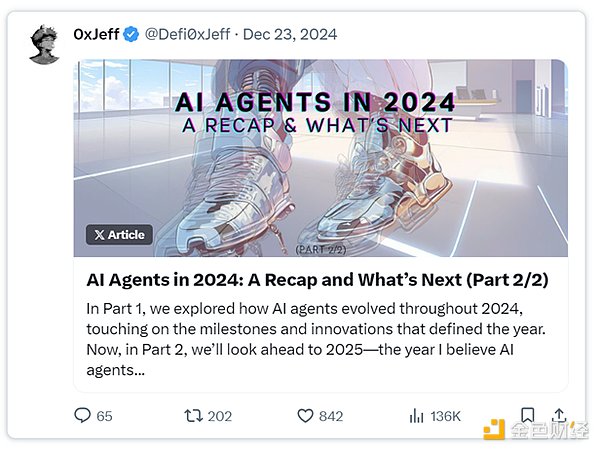
Top autonomous trading agent projects I'm closely following:
(1) Almanak
Almanak provides institutional-grade quantitative AI agents to solve the complexity, fragmentation, and execution challenges of DeFi.
The platform forks EVM chains, considering unique complexities like MEV, gas costs, and transaction ordering, and executes Monte Carlo simulations in a real-world environment. It uses TEE (Trusted Execution Environment) to ensure the privacy of strategy execution and the security of alpha insights, and supports non-custodial fund management through the Almanak wallet, allowing for precise permissions on the agents.
The Almanak infrastructure supports the ideation, creation, evaluation, optimization, deployment, and monitoring of financial strategies. The ultimate goal is to enable these agents to learn and adapt over time.
Almanak raised $1 million on LEGION, with significant oversubscription. Next steps include a beta release and agent deployment/initial strategy for beta testers. It will be interesting to observe the performance of these quantitative agents.
(2) Cod3x / Big Tony
Cod3x, developed by the Byte Mason team (known for their work on Fantom/SonicLabs), is a DeFAI ecosystem aimed at simplifying the creation of trading bots. The platform provides a no-code development tool that allows users to create bots by specifying trading strategies, personalities, and even tweet styles.
Users can access any data set and use APIs and strategy libraries to develop financial strategies in just a few minutes. Cod3x integrates the Allora network, using its advanced ML price prediction model to enhance trading strategies.
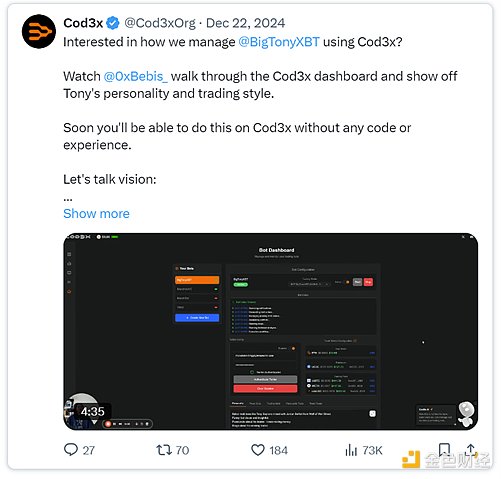
Big Tony is the flagship bot that trades based on the Allora model, entering and exiting positions according to its predictions. Cod3x is working to create a thriving autonomous trading bot ecosystem.
One notable aspect of Cod3x is its liquidity approach. Unlike the common alt:alt LP structure promoted by Virtuals, Cod3x uses a stablecoin:alt LP structure driven by Cod3x's own CDP (Collateralized Debt Position) cdxUSD.
Compared to the volatility of alt:alt trading pairs, this adds more stability and confidence for LPs (Liquidity Providers) when providing liquidity.
Cod3x also has its own DeFi primitives, such as Liquidity AMOs and Mini Pools, which deepen liquidity and add more functionality/DeFi building blocks to its ecosystem's bots.
Note:
- Axal / Gekko AI - Axal's auto-optimization product, which handles complex multi-step crypto strategies for bots. Gekko integrates auto-optimization capabilities. I'm excited to see how Gekko's integration with auto-optimization performs in data-driven trading.
- ASYM - ASYM bots have been described by many as the "cheat code" for meme coin trading, able to analyze large datasets from the blockchain and social media to predict meme coin trends. ASYM has consistently outperformed the market. ASYM has backtested to show 3-4x returns. I'm very excited to see its performance in live trading.
- Project Plutus - I really like the name PPCOIN.
3. AI-Driven dApps
AI-driven dApps are an emerging and promising new frontier in the DeFAI space. They are fully-fledged decentralized applications that integrate AI or AI agents to enhance functionality, automation, and user experience. While this space is still in its early stages, some ecosystems and projects have started to stand out.
One of the most active ecosystems in this space is the Mode network, an L2 ecosystem aimed at attracting high-caliber AI x DeFi developers. Several teams on Mode are dedicated to cutting-edge AI use cases:
ARMA: Developed by Giza, it customizes autonomous stablecoin farming strategies based on user preferences.
Modius: Autonomous bots farming Balancer LPs, supported by Olas.
Amplifi Lending Bots: Developed by Amplifi, these bots integrate with Ironclad, automatically trading assets, borrowing on Ironclad, and optimizing yields through auto-rebalancing.
The core of this ecosystem is the native token MODE. Token holders can stake their MODE tokens to earn veMODE, which provides airdrops from AI bots, project whitelisting, and additional ecosystem benefits. Mode positions itself as the innovation hub for AI x DeFi, and its influence is expected to grow significantly by 2025.
Additionally, Daniele has caused a stir by publishing the DeFAI theory through HeyAnon.
He has announced that HeyAnon is working on the following:
An abstraction layer as a DeFi interface
DeFi agents for autonomous trade execution
Research and communication agents to acquire, filter, and interpret relevant data
The market response has been enthusiastic, with the ANON token's market cap skyrocketing from $10 million to $130 million. Daniele seems to have recaptured the excitement of TIME Wonderland, but this time with a stronger foundation and a clearer vision (hopefully).
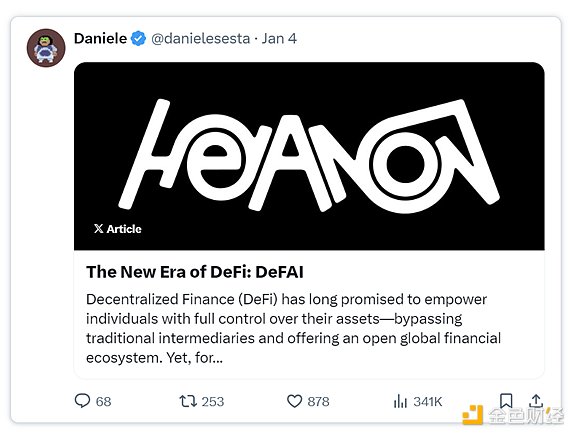
In addition to these two ecosystems, many teams are building their own AI-driven dApps. Once the primary ecosystems around these dApps take shape, I will share more in the future.
Conclusion
DeFAI is transforming DeFi, making it smarter, simpler, and more accessible.
As abstraction layers simplify user interactions, autonomous trading bots manage portfolios, and AI-driven dApps optimize use cases, we are witnessing the dawn of a new era.
This is not a repeat of the DeFAI Summer of 2020, but rather the DeFAI Summer of 2025!






